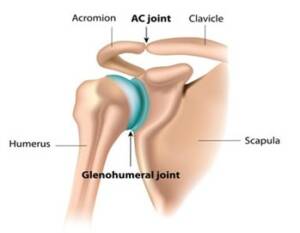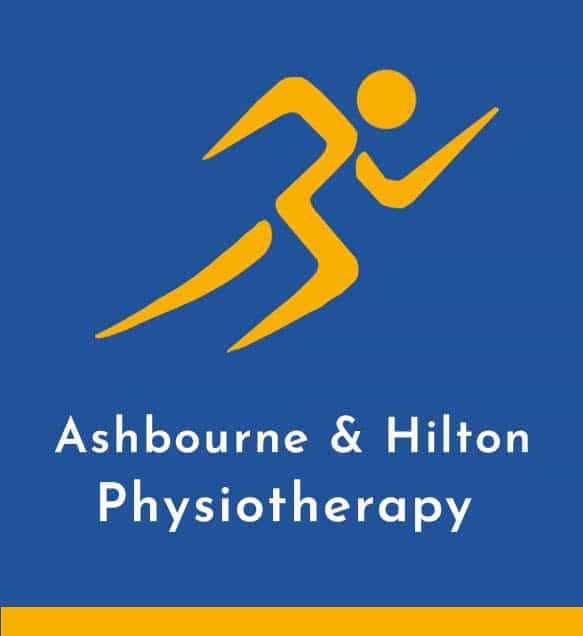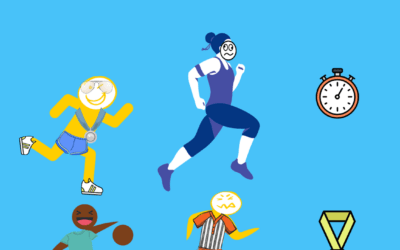
Image credit: www.centralperformance.com
Shoulder facts!
The main joint of the shoulder is the ‘ball and socket’ joint, or glenohumeral joint, but did you know there are also 2 other joints: the ACJ joint (where the collar bone meets the shoulder blade, towards the outer edge of your shoulder) and the SCJ (not pictured here, but where the collar bone meets your chest bone)?

Image credit: www.sportsinjuryclinic.net
- The glenohumeral joint is a ball articulating on a fairly shallow socket, which gives our shoulder joint a large range of movement. For this reason, the glenohumeral joint relies greatly on the soft tissues (muscles, tendons and ligaments) for its support and stability.
- Most people are expected to experience shoulder pain at some point in their lives and is the 3rd most common musculoskeletal problem causing people to seek help at their GP surgery.
A bit about me (and how I can help you!)
My name is Katie Walstow, and I am an experienced Physiotherapist with a particular interest in shoulder problems. I started out my Physiotherapy journey by attending the University of Derby, where I obtained a degree in Sport and Exercise Science. From there, I went to the University of Birmingham to become a qualified Physiotherapist by completing a Masters degree in 2012. I have spent most of my career working within the NHS, which has been incredibly varied with lots of opportunities for taking on additional training, such as interpreting X-rays and performing corticosteroid injections. I have also worked alongside passionate and inspiring colleagues, who sparked my interest in the world of shoulders! In April of 2023, in search of a slightly different path, I was fortunate enough to be welcomed into the Ashbourne and Hilton Physiotherapy Clinics, where I work part-time alongside my NHS role.

“Here I am enjoying a scenic cycle in our beautiful Derbyshire countryside!”
I enjoy treating people of all ages and abilities with their shoulder problems, whether that be a young person who dislocated their shoulder playing sport, an older person who would like to be able to reach a plate out of their cupboard, and anyone and everyone in-between!
I feel that the shoulder is a hugely important part of the body, allowing us to use our hands in day to day activities. I strive to provide a listening ear, to really understand the problem and how it started, and establish goals we can work towards. I get huge satisfaction from a patient leaving my clinic room feeling valued, listened to, and clear about how to move forwards with their problem.
Subacromial shoulder pain
The most common cause of shoulder pain is known as “subacromial shoulder pain”, frequently causing pain in the shoulder itself and upper arm, and sometimes radiating further down the arm or shoulder blade. It is usually due to inflammation around the tendons of your shoulder (the ‘rotator cuff’), which provides shoulder stability and movement. This can be due to a change in the amount you are using your arm, a trauma or other health and lifestyle factors. This problem has been known by many names over the years, including impingement, bursitis, and tendinopathy; however, in more recent years it sits neatly under the umbrella term “subacromial shoulder pain”.
Subacromial shoulder pain tends to feel worse when lying on that side in bed, reaching around to your back, or when moving your arm away from your body, particularly if you are holding something weighty in your hand.
The good news is that subacromial shoulder pain often settles down with time, however sometimes it can be quite painful and this can persist for many months. The British Elbow and Shoulder Society has put together a booklet of self-help advice and exercises which you can try out, if you think you may have subacromial shoulder pain: Exercises to treat Subacromial shoulder pain
Although movement can be sore, symptoms usually improve over the course of a several weeks with simple exercises to regain range of motion and function. Book an appointment to see one our Chartered Physiotherapists, for a thorough assessment and treatment plan to help you get back to doing the things you love!


References
Rees, J., Kulkarni, R., Gibson, J and Connor, C. (2018) Subacromial Shoulder Pain. Available at: https://bess.ac.uk/subacromial-pain/ (Accessed 3/10/23)
To book an appointment with Katie please call:
Ashbourne Clinic: 01335 344952
Hilton Clinic: 01283 777070
#ashbournephysio #ashbournephysiotherapycentre #hiltonphysio #hilton #shoulderpain #shoulderinjuries #physiotherapy #rehab #rehabilitation #sportsjury #subacromialpain #treatment #dislocatedshoulder #dislocatedjoint #tendons #tendoninjury #pain #ball&socketjoint




